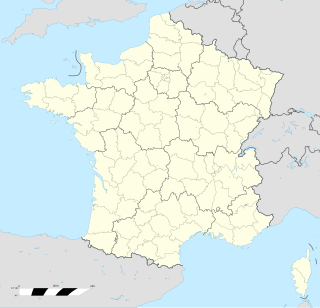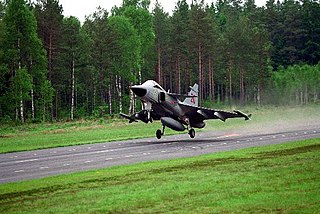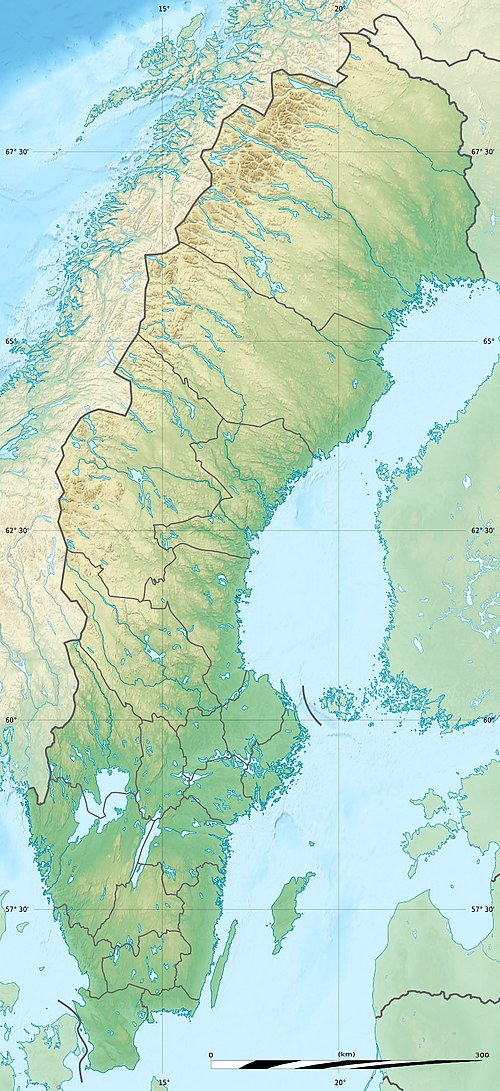
The Saab 37 Viggen is a retired Swedish single-seat, single-engine, short-medium range combat aircraft. Development work on the type was initiated at Saab in 1952 and, following the selection of a radical delta wing configuration, the resulting aircraft performed its first flight on 8 February 1967 and entered service in 21 June 1971. It was the first canard design produced in quantity. The Viggen was also the most advanced fighter jet in Europe until the introduction of the Panavia Tornado into operational service in 1981.

An air base is an aerodrome used as a military base by a military force for the operation of military aircraft.

The Saab 35 Draken is a Swedish fighter-interceptor developed and manufactured by Svenska Aeroplan Aktiebolaget (SAAB) between 1955 and 1974. Development of the Saab 35 Draken started in 1948 as the Swedish air force future replacement for the then also in development Saab 29 Tunnan dayfighter and Saab 32B Lansen night fighter. It featured an innovative but unproven double delta wing, which led to the creation of a sub-scale test aircraft, the Saab 210, which was produced and flown to test this previously-unexplored aerodynamic feature. The full-scale production version entered service with frontline squadrons of the Swedish Air Force on 8 March 1960. It received the designation Flygplan 35 and was produced in several variants and types, most commonly as a fighter type with the prefix J, standing for Jaktflygplan (Pursuit-aircraft), the Swedish term for fighter aircraft.

The Swedish Air Force is the air force branch of the Swedish Armed Forces.
Offensive counter-air (OCA) is a military term for the suppression of an enemy's military air power, primarily through ground attacks targeting enemy air bases: disabling or destroying parked aircraft, runways, fuel facilities, hangars, air traffic control facilities and other aviation infrastructure. Ground munitions like bombs are typically less expensive than more sophisticated air-to-air munitions, and a single ground munition can destroy or disable multiple aircraft in a very short time whereas aircraft already flying must typically be shot down one at a time. Enemy aircraft already flying also represent an imminent threat as they can usually fire back, and therefore destroying them before they can take off minimizes the risk to friendly aircraft.

A hardened aircraft shelter (HAS) or protective aircraft shelter (PAS) is a reinforced hangar to house and protect military aircraft from enemy attack. Cost considerations and building practicalities limit their use to fighter size aircraft.

Operation Focus was the opening airstrike by Israel at the start of the Six-Day War in 1967. It is sometimes referred to as the "Sinai Air Strike". At 07:45 on June 5, 1967, the Israeli Air Force (IAF) under Maj. Gen. Mordechai Hod launched a massive airstrike that destroyed the majority of the Egyptian Air Force on the ground. Following Syrian, Jordanian, and Iraqi attacks in retaliation, the Israeli Air Force proceeded to bomb air bases in those countries. By noon, the Egyptian, Jordanian and Syrian Air Forces, with about 450 aircraft, were destroyed. It was also very successful in disabling 18 airfields in Egypt, hindering Egyptian Air Force operations for the duration of the war, and remains one of the most successful air attack campaigns in military history.

Operation Daisy was a military operation conducted from November 1–20, 1981 by the South African Defence Force and South West African Territorial Force (SWATF) in Angola during the South African Border War and Angolan Civil War. This conflict was sparked when the South African Defence Force decided to try to halt the regroup of the active military branch of SWAPO, also known as the People's Liberation Army of Namibia.

Laon-Couvron Air Base is a former French and United States Air Force base in France. It is located in the Aisne département of France, less than one mile southeast of the village of Couvron and 6 miles northwest of Laon; on the southwest side of the Autoroute des Anglais 1 Mile (1.6 km) east of the village of Couvron-et-Aumencourt.
Lower Norrland Military District, originally II Military District was a Swedish military district, a command of the Swedish Armed Forces that had operational control over Lower Norrland, for most time of its existence corresponding to the area covered by the counties of Västernorrland, Jämtland and the northern part of Gävleborg. The headquarters of Milo NN were located in Östersund.

[Swedish] Tactical and Air Defence Control System in forms of STRIL 50 and STRIL 60 were integrated systems for aerial warfare control including early warning radar and ground-controlled interception. The systems depended on radar and radio as primary technologies but STRIL 50 was based on manual control while STRIL 60 applied the usage of early digital computers.

A highway strip, road runway or road base is a section of a highway, motorway or other form of public road that is specially built to act as a runway for (mostly) military aircraft and to serve as an auxiliary military air base. These runways allow military aircraft to continue operating even if their regular air bases, some of the most vulnerable targets in any war, are degraded or destroyed.

Saint-Simon – Clastres Air Base is an abandoned military airfield, which is located approximately 3 km (2 NM) northwest of Clastres and east of Saint-Simon, both communes in the Aisne department of the Picardy (Picardie) region in France. It is approximately 116 km (63 NM) north-northeast of Paris.

Laon-Athies Air Base is an abandoned military airfield, which is located near the city of Laon in the Aisne department of France.

Giebelstadt Army Airfield is a closed military airfield located in Germany, southwest of Giebelstadt in Bavaria, approximately 250 miles southwest of Berlin. It was turned over to the German government on 23 June 2006 and is now Giebelstadt Airport, a general aviation airport.

Air force ground forces and special forces are ground forces, and may include special operations units that are part of a nation's air force. Airmen assigned to such units may be trained, armed and equipped for ground combat and special operations.
First Air Group, previously named Air Group and later named Attack Group was an air group unit in the Swedish Air Force. The First Air Group was the collective name given to the attack wings who would jointly carry out heavier attacks in the event of war. It was active in various formations from 1938 to 1995. It was directly subordinate to the Supreme Commander of the Swedish Armed Forces and therefore nicknamed ÖB:s klubba.

Bas 90 was an air base system used by the Swedish Air Force during the Cold War. Bas 90 was developed during the 1970s and 1980s from the existing Bas 60 system in response to the new threats and needs that had arisen since the conception of the Bas 60 system during the 1950s. Like its predecessor, the Bas 90 system was based around defensive force dispersal of aircraft across many krigsflygbaser in case of war, as well as dispersion of the air base functions within the individual bases themselves. The air units would have been dispersed so one squadron would be stationed per krigsflygbas. The system was a protective measure against nuclear weapons and airstrikes, the purpose being to make it complicated for an opponent to destroy the Swedish Air Force on the ground and thus ensure endurance for the air force in a conflict scenario.
Major General Erik Gustav Vilhelm Nygren was a Swedish Air Force officer. Nygren's senior command was Chief of the Air Staff from 1978 to 1980 and commanding officer of the Attack Group from 1980 to 1983.
The Defence Act of 1958 was a defence act passed by the Swedish Riksdag on 4 February 1958. It was made with Prague Coup, Korean War and Hungarian Revolution of 1956 as a background, where the threat of nuclear weapons, adaptability and possible acquisition of a Swedish nuclear weapon also played a role.




















